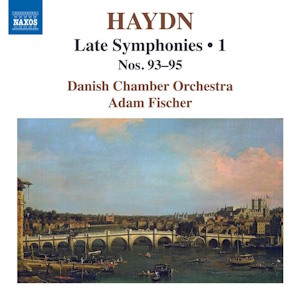
Franz Joseph Haydn (1732-1809)
Late Symphonies Volume 1
Symphony No. 93 (1791)
Symphony No. 94 ‘The Surprise’ (1791)
Symphony No. 95 (1791)
Danish Chamber Orchestra/Ádám Fischer
rec. 2022, Concert Hall, Royal Danish Academy of Music, Copenhagen, Denmark
Naxos 8.574516 [60]
The Danish Chamber Orchestra has a very bright, varied and energetic playing style; conductor Ádám Fischer in his notes goes out of his way to explain in some detail how they have cultivated specifically “stormy” artistic effects: “With the strings, we often use a series of fast, short strokes at the bow frog for marcato effects. We also constantly vary the playing styles sul tasto, (on the “sweet spot”), sul ponticello (close to the bridge to make a wiry sound), flautando (playing near the fingerboard to produce a “fluty” sound) etc. To achieve greater variation in expression, we deliberately use different bow techniques such as battuta and ricochet, which have a more lively (sic) effect than ‘normal’ bowing. With the winds, we often vary the swelling and decreasing sound with sustained notes. We use ‘quiet forte’ and ‘loud piano’ because we are convinced that the character of the sound, not its decibel value, determines the dynamics, among other elements.” Some of that sounds to me like the application of standard “period” devices and I admit to not quite understanding what is meant by the last point, but I had hoped that by listening to the performances that would be clarified.
In 2020, I glowingly reviewed the Brilliant box set of “Name Symphonies”, again conducted by Fischer but with the Austro-Hungarian Haydn Orchestra; that contains only “The Surprise” symphony for my purposes of comparison, but Fischer remarked in the notes for that set that “[a] boring performance remains a crime, even if it is historically ‘correct’” and again here he says, “We believe that boredom must be declared war upon”. In addition to revisiting that earlier recording, I listened to some old favourites including Bernstein and Szell – but not before I had first listened to this, so as to taste it with a clean palate, as it were. Hard timpani thwacks, a leaner, more acerbic string tone, more urgent tempi and greater prominence to the wind and brass instrument all bespeak a “period-informed” approach. In some ways I prefer the “fuller fat” sound of Fischer’s earlier recording and of course the older conductors take far more time over the Andante movements, but in fact I find myself enjoying them all equally. Which poses the questions: if you already have some favourite recordings, do you need to add these to your collection? Or if you are a first time buyer, is this the best introduction to these works? Personally, I like a little more weight and gravitas to the playing of my Haydn symphonies but there is a sprightly energy about the playing here which is most seductive. Articulation and phrasing are so neat and individual, solo contributions such as that of the bassoon in the slow movement of No. 93 are always engaging; little touches like the prominent col legno interjections in the finale are fun, too.
One of my favourite passages in all of Haydn’s symphonies is the skipping, three-quarter-time passage which first appears two minutes into the first movement of “The Surprise” and a minute after the start of the vivace assai section, here delivered with wit and charm. Music like this vindicates Fischer’s claim that Haydn’s symphonies have been unfairly overshadowed by Mozart’s and Beethoven’s. The dynamics of the “surprise” itself in the Andante are nicely managed, although at just over five minutes the timing does seem a little hasty to me and the Menuetto could be a tad more galumphing to bring out its rustic good humour. The finale is certainly exhilarating.
I do not think No. 95 is as inspired a symphony as its two predecessors but it receives the best possible advocacy here. All in all, this is a thoroughly enjoyable trio of mature Haydn symphonies.
Keith Anderson provides a brief biographical notes and useful little guides to each of these three London symphonies which work neatly in tandem with Fischer’s note.
Ralph Moore
Help us financially by purchasing from





















